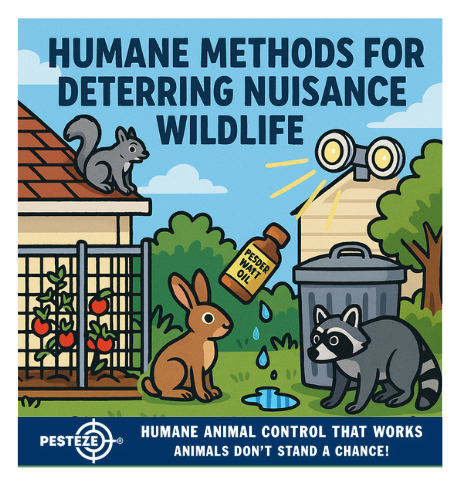HUMANE METHODS FOR DETERRING NUISANCE WILDLIFE

HUMANE METHODS FOR DETERRING NUISANCE WILDLIFE
SUMMARY
Wildlife can sometimes become a nuisance when they invade gardens, attics, or yards. This guide explains humane, safe, and effective ways to deter unwanted animals while respecting their role in the ecosystem.
FEATURES
-
Identify attractants: Remove food, water, and shelter sources.
-
Seal entry points: Block gaps in homes, attics, and crawl spaces.
-
Use natural deterrents: Scents like peppermint oil or vinegar repel animals.
-
Install barriers: Fencing, mesh, and netting keep wildlife out.
-
Apply motion devices: Lights, sprinklers, or sound startle animals.
-
Seek professional help: Wildlife experts provide safe, lasting solutions.
GUIDE DESCRIPTION
Nuisance wildlife issues are common in both urban and rural areas. Raccoons raid trash cans, deer eat garden plants, squirrels chew wiring, and birds nest in attics. While these animals can cause frustration, the best solutions are humane methods for deterring nuisance wildlife that protect your property without harming the creatures.
The first step is to identify and remove attractants. Animals are usually drawn by easy access to food, water, or shelter. Keep trash cans sealed with tight-fitting lids, avoid leaving pet food outside, and eliminate standing water around your home. Clean up fallen fruit, birdseed, and compost piles that may encourage visits.
Next, seal entry points. Wildlife often sneaks indoors through small gaps in siding, vents, chimneys, or roofing. Inspect your property and close these access points using durable materials such as mesh, caulk, or vent covers. Ensure no animals are trapped inside before sealing.
Natural deterrents are another useful tool. Strong scents such as peppermint oil, vinegar, garlic, or predator urine (available commercially) can discourage animals from approaching certain areas. These options are non-toxic and safe for pets and children when applied carefully.
For more persistent problems, install barriers. Fencing around gardens, hardware cloth around crawl spaces, or bird netting over fruit trees creates a physical shield that wildlife cannot easily bypass. Choose sturdy materials to withstand chewing or clawing.
Motion-activated devices are highly effective because they surprise animals without causing harm. Sprinklers that spray when triggered, lights that turn on suddenly, or ultrasonic sound devices can condition animals to avoid your property.
Finally, if problems continue, seek professional help. Licensed wildlife control experts can evaluate your situation, suggest humane solutions, and ensure compliance with local laws. In some cases, professional assistance is the safest and most effective option.
By combining these strategies—removing attractants, blocking entry points, using deterrents, and installing barriers—you can protect your home and yard while respecting the balance of nature. Humane methods not only safeguard wildlife but also provide long-lasting results.
- Saneeth Thota


Comments 0